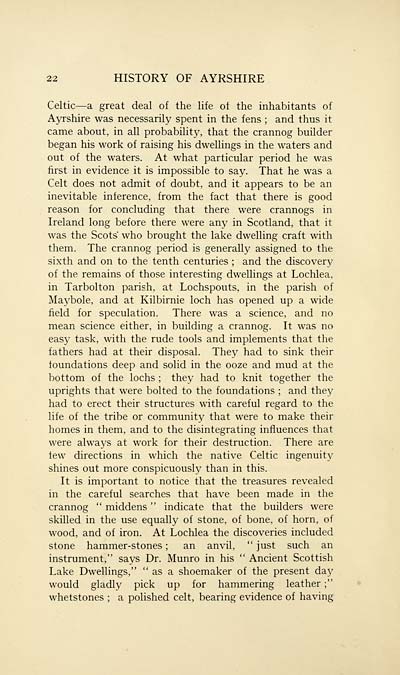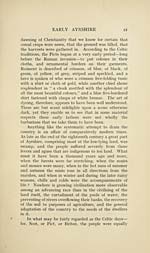Download files
Complete book:
Individual page:
Thumbnail gallery: Grid view | List view

22 HISTORY OF AYRSHIRE
Celtic — a great deal of the life of the inhabitants of
Ayrshire was necessarily spent in the fens ; and thus it
came about, in all probability, that the crannog builder
began his work of raising his dwellings in the waters and
out of the waters. At what particular period he was
first in evidence it is impossible to say. That he was a
Celt does not admit of doubt, and it appears to be an
inevitable inference, from the fact that there is good
reason for concluding that there were crannogs in
Ireland long before there were any in Scotland, that it
was the Scots' who brought the lake dwelling craft with
them. The crannog period is generally assigned to the
sixth and on to the tenth centuries ; and the discovery
of the remains of those interesting dwellings at Lochlea,
in Tarbolton parish, at Lochspouts, in the parish of
Maybole, and at Kilbirnie loch has opened up a wide
field for speculation. There was a science, and no
mean science either, in building a crannog. It was no
easy task, with the rude tools and implements that the
fathers had at their disposal. They had to sink their
foundations deep and solid in the ooze and mud at the
bottom of the lochs ; they had to knit together the
uprights that were bolted to the foundations ; and they
had to erect their structures with careful regard to the
life of the tribe or community that were to make their
homes in them, and to the disintegrating influences that
were always at work for their destruction. There are
lew directions in which the native Celtic ingenuity
shines out more conspicuously than in this.
It is important to notice that the treasures revealed
in the careful searches that have been made in the
crannog " middens " indicate that the builders were
skilled in the use equally of stone, of bone, of horn, of
wood, and of iron. At Lochlea the discoveries included
stone hammer-stones ; an anvil, " just such an
instrument," says Dr. Munro in his " Ancient Scottish
Lake Dwellings," " as a shoemaker of the present day
would gladly pick up for hammering leather ;"
whetstones ; a polished celt, bearing evidence of having
Celtic — a great deal of the life of the inhabitants of
Ayrshire was necessarily spent in the fens ; and thus it
came about, in all probability, that the crannog builder
began his work of raising his dwellings in the waters and
out of the waters. At what particular period he was
first in evidence it is impossible to say. That he was a
Celt does not admit of doubt, and it appears to be an
inevitable inference, from the fact that there is good
reason for concluding that there were crannogs in
Ireland long before there were any in Scotland, that it
was the Scots' who brought the lake dwelling craft with
them. The crannog period is generally assigned to the
sixth and on to the tenth centuries ; and the discovery
of the remains of those interesting dwellings at Lochlea,
in Tarbolton parish, at Lochspouts, in the parish of
Maybole, and at Kilbirnie loch has opened up a wide
field for speculation. There was a science, and no
mean science either, in building a crannog. It was no
easy task, with the rude tools and implements that the
fathers had at their disposal. They had to sink their
foundations deep and solid in the ooze and mud at the
bottom of the lochs ; they had to knit together the
uprights that were bolted to the foundations ; and they
had to erect their structures with careful regard to the
life of the tribe or community that were to make their
homes in them, and to the disintegrating influences that
were always at work for their destruction. There are
lew directions in which the native Celtic ingenuity
shines out more conspicuously than in this.
It is important to notice that the treasures revealed
in the careful searches that have been made in the
crannog " middens " indicate that the builders were
skilled in the use equally of stone, of bone, of horn, of
wood, and of iron. At Lochlea the discoveries included
stone hammer-stones ; an anvil, " just such an
instrument," says Dr. Munro in his " Ancient Scottish
Lake Dwellings," " as a shoemaker of the present day
would gladly pick up for hammering leather ;"
whetstones ; a polished celt, bearing evidence of having
Set display mode to:
![]() Universal Viewer |
Universal Viewer | ![]() Mirador |
Large image | Transcription
Mirador |
Large image | Transcription
Images and transcriptions on this page, including medium image downloads, may be used under the Creative Commons Attribution 4.0 International Licence unless otherwise stated. ![]()
| Histories of Scottish families > Ayrshire > Volume 1 > (32) Page 22 |
|---|
| Permanent URL | https://digital.nls.uk/95194670 |
|---|
| Attribution and copyright: |
|
|---|
| Description | A selection of almost 400 printed items relating to the history of Scottish families, mostly dating from the 19th and early 20th centuries. Includes memoirs, genealogies and clan histories, with a few produced by emigrant families. The earliest family history goes back to AD 916. |
|---|

